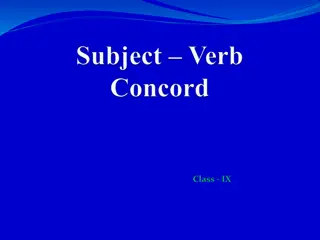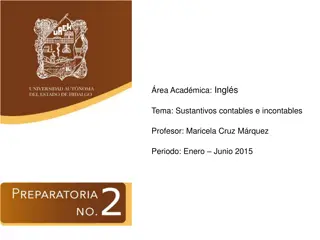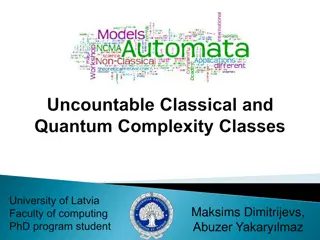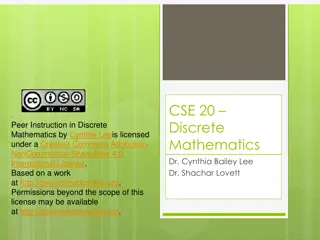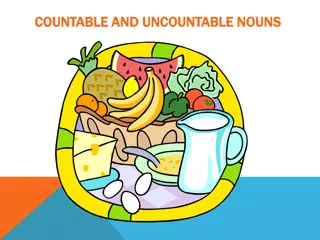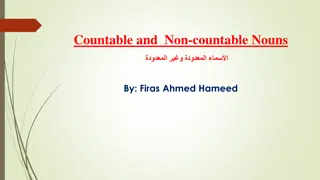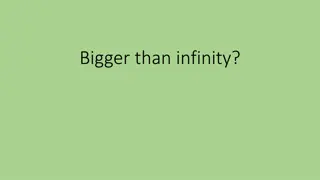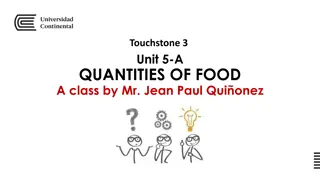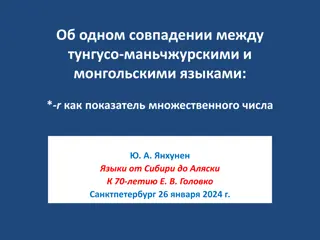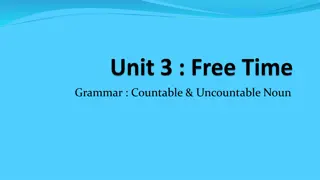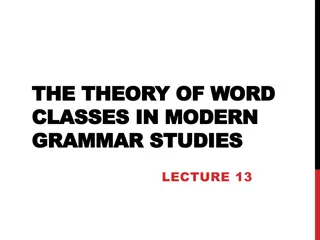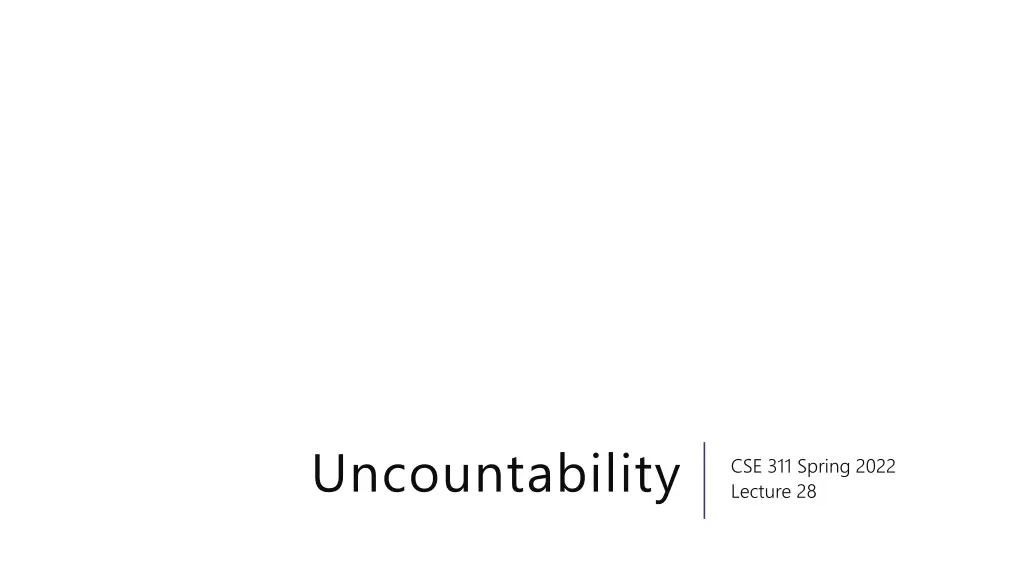
Understanding Uncountability in Computer Science
Explore the concept of uncountability in computer science as discussed in CSE 311's Spring 2022 Lecture 28. Delve into the subtleties of proofs, the challenge of finding a computer program for certain functions, and the significance of progress in understanding advanced theorems. Discover topics like sets, sizes, bijections, and more in this thought-provoking session.
Uploaded on | 0 Views
Download Presentation

Please find below an Image/Link to download the presentation.
The content on the website is provided AS IS for your information and personal use only. It may not be sold, licensed, or shared on other websites without obtaining consent from the author. If you encounter any issues during the download, it is possible that the publisher has removed the file from their server.
You are allowed to download the files provided on this website for personal or commercial use, subject to the condition that they are used lawfully. All files are the property of their respective owners.
The content on the website is provided AS IS for your information and personal use only. It may not be sold, licensed, or shared on other websites without obtaining consent from the author.
E N D
Presentation Transcript
Uncountability CSE 311 Spring 2022 Lecture 28
Announcements Final review materials are on the webpage!
Punchline for Todays Lecture There are more functions than there are computer programs. So for some functions there just isn t a computer program that computes it. The proofs today and Friday are subtle! They re counter-intuitive. And proof by contradiction, so hard to get intuition from them. Your takeaway from today and Friday should be look how far we ve come! 10 weeks ago, you wouldn t have fully understood the statements of these theorems. Now you can at least see the proofs, even if they might be a lot still and some details don t make sense yet.
Outline Some definitions what do we mean by more ? How many programs are there? Proving there are more functions.
Sizes of sets How do we know two sets are the same size? Easy. Count the number of elements in both. That works great for finite sets, but isn t really a number we get to count to
More Practical What does it mean that two sets have the same size?
More Practical What does it mean that two sets have the same size?
Bijection A function ?:? ? maps every element of ? to one element of ? ?is the domain , ?is the co-domain One-to-one (aka injection) A function ? is one-to-one iff ? ?(? ? = ? ? ? = ?) That is, every output has at most one possible input.
Bijection A function ?:? ? maps every element of ? to one element of ? ?is the domain , ?is the co-domain Onto (aka surjection) A function ?:? ? is onto iff ? ? ? ?(? = ?(?)) Every output has at least one input that maps to it.
Bijection Onto (aka surjection) One-to-one (aka injection) A function ? is one-to-one iff ? ?(? ? = ? ? ? = ?) A function ?:? ? is onto iff ? ? ? ?(? = ?(?)) Bijection A function ?:? ? is a bijection iff ? is one-to-one and onto A bijection maps every element of the domain to exactly the co-domain, and every element of the domain to exactly element of the domain. exactly one element of exactly one
Definition Two sets ?,? have the same size (same cardinality) if and only if there is a bijection ?:? ? This matches our intuition on finite sets. But it also works for infinite sets! Let s see just how infinite these sets are.
Some infinite sets Two sets ?,? have the same size (same cardinality) if and only if there is a bijection ?:? ? Let s compare the sizes of: , ,{? ? is an even integer}
Theyre all the same size. and even integers? ? ? = 2? Is it a bijection? ? ? = ? ? 2? = 2? ? = ?; If ? is even then ? = 2? for some integer ? and ? ? = ?. and ? 2 ?+1 if ? is even g ? = 2 if ? is odd
Theyre all the same size and even integers? ?(? ? ) will work nicely. You can also build one explicitly. Good exercise: show that if ? and ? are bijections then ? ? is also a bijection.
Countable Countable The set ? is countable iff there is an injection from ? to , Equivalently, ? is countable iff it is finite or there is a bijection from ? to , ,{?:? is an even integer} are all countable.
Lets Try one thats a little harder What about . There s gotta be more of those right? It s pretty intuitive to think there are more rationals than integers. The rationals are dense dense. Between every two rationals, there s another rational number. Or said in more intimidating fashion: between every two rationals there are infinitely many others!
The set of positive rational numbers 1/1 1/2 1/3 1/4 1/5 1/6 1/7 1/8 2/1 2/2 2/3 2/4 2/5 2/6 2/7 2/8 3/1 3/2 3/3 3/4 3/5 3/6 3/7 3/8 4/1 4/2 4/3 4/4 4/5 4/6 4/7 4/8 5/1 5/2 5/3 5/4 5/5 5/6 5/7 6/1 6/2 6/3 6/4 6/5 6/6 7/1 7/2 7/3 7/4 7/5 .... ... ... ... ... ... ... ... ... ... ... ...
In bijection with the natural numbers Order the rationals by their denominator (increasing), breaking ties by numerator. 1/1,1/2,1/3,2/3,1/4,3/4,1/5,2/5,3/5,4/5,1/6, ? ? =the ?th number in that list (indexed from 0) That s a bijection from to +(it s not a nice clean formula, but it s definitely a function)
In bijection with the natural numbers How do we get all of ? We already know how to get twice as many map the even naturals to positives, and the odds to negatives. Like when we were mapping to . Fun fact: The order via diagonals technique is closely related to dovetailing a super-useful technique in compuatability theory (take 431 to learn more)
Uncountable Alright. There are clever ways to build bijections. Is there anything that s bigger than ? And like how would we prove it?
A proof idea A set is countable iff it can be listed (a list is a bijection with ). We ll take advantage of that to find an uncountable set. Claim is uncountable. Actually, it s easier if we show [0,1) is uncountable (i.e. real numbers between 0 and 1).
What do real numbers look like 0. 3 3 3 3 3 3 3 3 0. 2 7 2 7 2 8 5 4 0. 1 4 1 5 9 2 6 5 0. 2 2 2 2 2 2 2 2 0. 1 2 3 4 5 6 7 8 0. 9 8 7 6 5 4 3 2 0. 8 2 7 6 4 5 7 4 0. 5 9 4 2 7 5 1 7 A string of digits! Well not a string An infinitely long sequence of digits is more accurate.
Uncountable Suppose, for the sake of contradiction, that [0,1) is countable. Then there is a bijection ?: [0,1). Use that bijection to make the following table
Proof that [0,1) is not countable Suppose, for the sake of contradiction, that there is a list of them: Number Digits after decimal 0 1 2 3 4 5 6 7 0. 3 3 3 3 3 3 3 3 ?(0) 0. 2 7 2 7 2 8 5 4 ?(1) 0. 1 4 1 5 9 2 6 5 ?(2) 0. 2 2 2 2 2 2 2 2 ?(3) 0. 1 2 3 4 5 6 7 8 ?(4) 0. 9 8 7 6 5 4 3 2 ?(5) 0. 8 2 7 6 4 5 7 4 ?(6) 0. 5 9 4 2 7 5 1 7 ?(7)
Proof that [0,1) is not countable Suppose, for the sake of contradiction, that there is a list of them: Number Digits after decimal 0 1 2 3 4 5 6 7 0. 3 3 3 3 3 3 3 3 ?(0) Goal: find a real number between 0 and 1 that isn t on our table. (contradiction to bijection) 0. 2 7 2 7 2 8 5 4 ?(1) 0. 1 4 1 5 9 2 6 5 ?(2) 0. 2 2 2 2 2 2 2 2 ?(3) 0. 1 2 3 4 5 6 7 8 ?(4) 0. 9 8 7 6 5 4 3 2 ?(5) 0. 8 2 7 6 4 5 7 4 ?(6) 0. 5 9 4 2 7 5 1 7 ?(7)
Proof that [0,1) is not countable Suppose, for the sake of contradiction, that there is a list of them: Number Digits after decimal 0 1 2 3 4 5 6 7 How do we find a number that s not in our list? 0. 3 3 3 3 3 3 3 3 ?(0) 0. 2 7 2 7 2 8 5 4 ?(1) 0. 1 4 1 5 9 2 6 5 ?(2) Well let s make sure whatever our number is, it s not ?(0) 0. 2 2 2 2 2 2 2 2 ?(3) 0. 1 2 3 4 5 6 7 8 ?(4) 0. 9 8 7 6 5 4 3 2 ?(5) 0. 8 2 7 6 4 5 7 4 ?(6) 0. 5 9 4 2 7 5 1 7 ?(7)
Proof that [0,1) is not countable Suppose, for the sake of contradiction, that there is a list of them: Number Digits after decimal 0 1 2 3 4 5 6 7 0. 3 3 3 3 3 3 3 3 ?(0) Well let s make sure whatever our number is, it s not ?(0) 0. 2 7 2 7 2 8 5 4 ?(1) 0. 1 4 1 5 9 2 6 5 ?(2) Set the 0 column to not 3, say 7. 0. 2 2 2 2 2 2 2 2 ?(3) 0. 1 2 3 4 5 6 7 8 ?(4) 0. 9 8 7 6 5 4 3 2 ?(5) 0. 8 2 7 6 4 5 7 4 ?(6) 0. 5 9 4 2 7 5 1 7 ?(7) 0.7
Proof that [0,1) is not countable Suppose, for the sake of contradiction, that there is a list of them: Number Digits after decimal 0 1 2 3 4 5 6 7 0. 3 3 3 3 3 3 3 3 ?(0) Well let s make sure whatever our number is, it s not ?(1) 0. 2 7 2 7 2 8 5 4 ?(1) 0. 1 4 1 5 9 2 6 5 ?(2) Set the 1 column to not 7, say 3. 0. 2 2 2 2 2 2 2 2 ?(3) 0. 1 2 3 4 5 6 7 8 ?(4) 0. 9 8 7 6 5 4 3 2 ?(5) 0. 8 2 7 6 4 5 7 4 ?(6) 0. 5 9 4 2 7 5 1 7 ?(7) 0.73
Proof that [0,1) is not countable Suppose, for the sake of contradiction, that there is a list of them: Number Digits after decimal 0 1 2 3 4 5 6 7 0. 3 3 3 3 3 3 3 3 ?(0) Well let s make sure whatever our number is, it s not ?(2) 0. 2 7 2 7 2 8 5 4 ?(1) 0. 1 4 1 5 9 2 6 5 ?(2) Set the 2 column to not 1, say 7. 0. 2 2 2 2 2 2 2 2 ?(3) 0. 1 2 3 4 5 6 7 8 ?(4) 0. 9 8 7 6 5 4 3 2 ?(5) 0. 8 2 7 6 4 5 7 4 ?(6) 0. 5 9 4 2 7 5 1 7 ?(7) 0.737
Proof that [0,1) is not countable Suppose, for the sake of contradiction, that there is a list of them: Number Digits after decimal 0 1 2 3 4 5 6 7 0. 3 3 3 3 3 3 3 3 ?(0) Flipping Rule: Flipping Rule: let s set the ?? column to: column to: ? if if ?(?) s s ??? column is not column is not ? ? if if ? ? ???? column is 0. 2 7 2 7 2 8 5 4 ?(1) 0. 1 4 1 5 9 2 6 5 ?(2) column is ?. . 0. 2 2 2 2 2 2 2 2 ?(3) 0. 1 2 3 4 5 6 7 8 ?(4) 0. 9 8 7 6 5 4 3 2 ?(5) 0. 8 2 7 6 4 5 7 4 ?(6) 0. 5 9 4 2 7 5 1 7 ?(7) 0.73777733
Wrapping Up 0.73777733 What is it? It s a real number between 0 and 1(!!!) Is the number on the list? Well it s not ?(0), they differ in column 0. It s not ? 1 , they differ in column 1. It s not ?(?), they differ in column ?. But ?was a bijection. That s a contradiction!
Diagonalization This proof technique is called diagonalization Often Cantor s Diagonalization (after Cantor, who developed it). diagonalization
Takeaway 1 There are differing levels of infinity. Some infinite sets are equal in size. Other infinite sets are bigger than others. If this is mind-bending you re in good company. Cantor s contemporaries accused him of being a scientific charlatan and a corruptor of youth But Cantor was right and his ideas eventually were recognized as correct.
Lets Do Another! Let ? = 0,1 . Call a function ?: ?a binary valued function Intuitively, ? would be something like public boolean g(BigInteger input){ } If we could write that ? in Java. How many possible ?: ? are there?
Proof that [0,1) set of binary-valued functions is not countable Suppose, for the sake of contradiction, that there is a list of them: ? bijection from to function Output on ? Output on 1 Output on 2 Output on 3 Output on 4 Output on 5 Output on 6 Output on 7 1 0 1 1 1 0 1 1 ?(0) 0 1 1 0 0 1 0 0 ?(1) 1 1 1 0 0 0 1 1 ?(2) 0 0 0 0 0 0 0 0 ?(3) 1 0 1 1 1 0 1 1 ?(4) 0 0 0 1 0 1 1 1 ?(5) 1 1 0 1 0 1 1 0 ?(6) 0 2 0 1 1 0 1 0 ?(7)
Proof that [0,1) set of binary-valued functions is not countable Suppose, for the sake of contradiction, that there is a list of them: ? bijection from to function Output on ? Output on 1 Output on 2 Output on 3 Output on 4 Output on 5 Output on 6 Output on 7 1 0 1 1 1 0 1 1 ?(0) Goal: find a function ?????: 0,1 that isn t on our table. (contradiction to bijection) 0 1 1 0 0 1 0 0 ?(1) 1 1 1 0 0 0 1 1 ?(2) 0 0 0 0 0 0 0 0 ?(3) 1 0 1 1 1 0 1 1 ?(4) 0 0 0 1 0 1 1 1 ?(5) 1 1 0 1 0 1 1 0 ?(6) 0 2 0 1 1 0 1 0 ?(7)
Proof that [0,1) set of binary-valued functions is not countable Suppose, for the sake of contradiction, that there is a list of them: ? bijection from to function Output on ? Output on 1 Output on 2 Output on 3 Output on 4 Output on 5 Output on 6 Output on 7 How do we find a function not on our list? Well to make sure it s not ?(0) (the function in the first row) Have ?????0 = 0 1 0 1 1 1 0 1 1 ?(0) 0 1 1 0 0 1 0 0 ?(1) 1 1 1 0 0 0 1 1 ?(2) 0 0 0 0 0 0 0 0 ?(3) 1 0 1 1 1 0 1 1 ?(4) 0 0 0 1 0 1 1 1 ?(5) 1 1 0 1 0 1 1 0 ?(6) 0 ?? ? = 1 0 2 0 1 1 0 1 0 ?(7) ?????? =
Proof that [0,1) set of binary-valued functions is not countable Suppose, for the sake of contradiction, that there is a list of them: ? bijection from to function Output on ? Output on 1 Output on 2 Output on 3 Output on 4 Output on 5 Output on 6 Output on 7 How do we find a function not on our list? Well to make sure it s not ?(0) (the function in the first row) Have ?????0 = 0 1 0 1 1 1 0 1 1 ?(0) 0 1 1 0 0 1 0 0 ?(1) 1 1 1 0 0 0 1 1 ?(2) 0 0 0 0 0 0 0 0 ?(3) 1 0 1 1 1 0 1 1 ?(4) 0 0 0 1 0 1 1 1 ?(5) 1 1 0 1 0 1 1 0 ?(6) 0 ?? ? = 1 0 2 0 1 1 0 1 0 ?(7) ?????? =
Proof that [0,1) set of binary-valued functions is not countable Suppose, for the sake of contradiction, that there is a list of them: ? bijection from to function Output on ? Output on 1 Output on 2 Output on 3 Output on 4 Output on 5 Output on 6 Output on 7 How do we find a function not on our list? Well to make sure it s not ?(?) (the function in the ?? row) Have ?????? = 1 ? ? ? 1 0 1 1 1 0 1 1 ?(0) 0 1 1 0 0 1 0 0 ?(1) 1 1 1 0 0 0 1 1 ?(2) 0 0 0 0 0 0 0 0 ?(3) 1 0 1 1 1 0 1 1 ?(4) 0 0 0 1 0 1 1 1 ?(5) 1 1 0 1 0 1 1 0 ?(6) 0 ?? ? = 1 0 2 0 1 1 0 1 0 ?(7) ?????? =
Proof that [0,1) set of binary-valued functions is not countable Suppose, for the sake of contradiction, that there is a list of them: ? bijection from to function Output on ? Output on 1 Output on 2 Output on 3 Output on 4 Output on 5 Output on 6 Output on 7 How do we find a function not on our list? Well to make sure it s not ?(?) (the function in the ?? row) Have ?????? = 1 ? ? ? 1 0 1 1 1 0 1 1 ?(0) 0 1 1 0 0 1 0 0 ?(1) 1 1 1 0 0 0 1 1 ?(2) 0 0 0 0 0 0 0 0 ?(3) 1 0 1 1 1 0 1 1 ?(4) 0 0 0 1 0 1 1 1 ?(5) 1 1 0 1 0 1 1 0 ?(6) 1 ?? ? ? outputs 0 on input ? 0 ?? ? ? outputs 0 on input ? 0 2 0 1 1 0 1 0 ?(7) ?????? =
Wrapping up the proof Wrapping up the proof. Observe that ?????is a fully-defined function, and that it has as its domain and {0,1} as its codomain. It therefore should be in the co- domain of ?. But it cannot be on the list, as ?(?) is different from the function in the ?? row on input ? for all ?. This contradicts ? being onto! So we have that the set of binary-valued functions (with as their domains) is uncountable.
Our Second big takeaway How many Java methods can we write: public boolean g(int input) ? Can you list them? Yeah!! Put them in lexicographic i.e. in increasing order of length, with ties broken by alphabetical order. lexicographic order Wait that means the number of such Java programs is countable. And the number of functions we re supposed to write is uncountable.
Our Second big takeaway There are more functions ?: ? than there are Java programs to compute them. Some function must be uncomputable That is there is no piece of code which tells you the output of the function when you give it the appropriate input. uncomputable.
Not just Java This isn t just about java programs. (all we used about java was that its programs are strings) that s well every programming language. There are functions that simply cannot be computed. Doesn t matter how clever you are. How fancy your new programming language is. Just doesn t work.* *there s a difference between int and here, for the proof to work you really need all integers to be valid inputs, not just integers in a certain range.
Does this matter? It s even worse than that almost all functions are not computable. So how come this has never happened to you? This might not be meaningful yet. Almost all functions are also inexpressible in a finite amount of English (English is a language too!) You ve probably never decided to write a program that computes a function you couldn t describe in English Are there any problems anyone is interested computable? interested in solving that aren t



